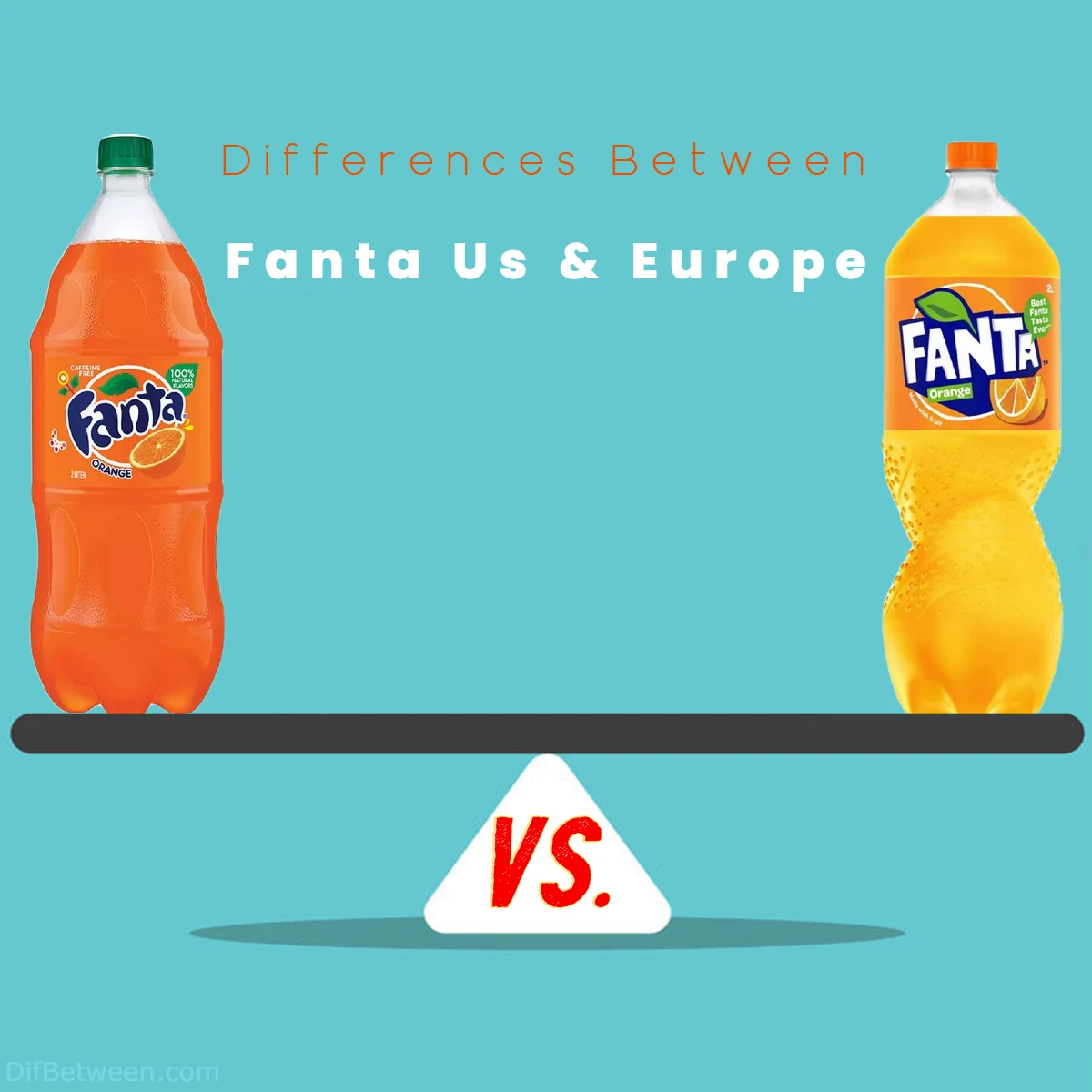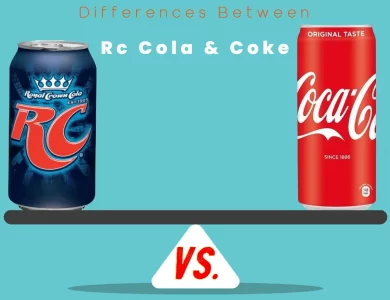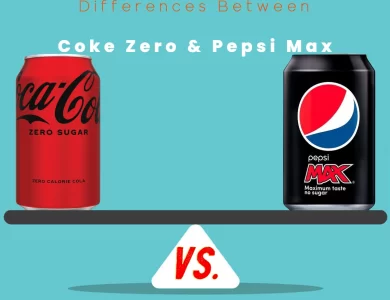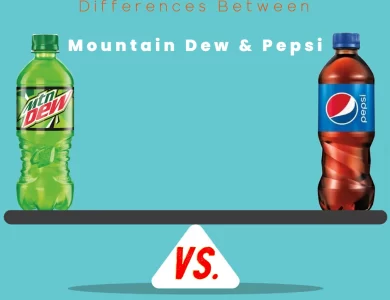
| Aspect | Fanta in the United States | Fanta in Europe |
|---|---|---|
| Historical Origins | Originated during World War II, created by Coca-Cola Company in the US. | Originated during World War II in Germany, created by Coca-Cola’s German division. |
| Flavor Variations | Primarily focuses on classic orange and grape flavors, with limited additional options like strawberry and pineapple. | Offers a wide range of flavors, including unique and exotic choices like passion fruit, blood orange, elderflower, and regional favorites such as melon in Spain or apple in Germany. |
| Sweeteners and Ingredients | Usually sweetened with high fructose corn syrup (HFCS) or sucrose. Contains carbonated water, natural flavors, citric acid, sodium citrate, and sodium benzoate (as a preservative). Ingredients may vary slightly based on flavor. | Uses natural sweeteners like sugar and steviol glycosides (stevia) instead of HFCS. Similar to the US, it contains carbonated water, natural flavors, citric acid, and preservatives, but with varying sweeteners. |
| Packaging and Sizing | Available in various formats, including individual cans (12 oz) and glass bottles (12 oz), as well as larger plastic bottles (20 oz or 2 liters). | Offered in individual serving sizes like cans (330ml) and bottles (500ml) and larger bottles (1.5 liters) for sharing. Some countries also have single-use glass bottles. |
| Marketing and Branding | Emphasizes a vibrant, youth-oriented image, with catchy jingles, engaging social media promotions, and collaborations with influencers or events. | Adapts marketing to specific countries, maintaining a lively, playful vibe that resonates with consumers of all ages. Collaborations with local artists and limited-edition flavors tied to seasonal events are common. |
| Availability of Exotic Flavors | Limited exotic flavors, primarily focused on mainstream fruit varieties. Availability may vary across different states. | A wide range of exotic and localized flavors cater to diverse tastes across the continent. Flavors may be specific to certain countries or regions. |
| Regional Preferences | Preferences may vary based on regional demographics and climates, with citrus flavors often popular in warmer regions. | Regional preferences influenced by diverse cultural backgrounds, with flavors tailored to local tastes and climates. |
| Limited Editions and Seasonal Offerings | Introduces occasional limited-edition flavors tied to popular holidays or events. | Frequently introduces limited editions and seasonal offerings, aligning with cultural festivities and local celebrations. |
| Cultural Integration | Aligned with American values and cultural touchpoints in marketing campaigns. | Adapts marketing to each country’s unique identity, resonating with local audiences. |
| Availability and Distribution | Widely available in various retail outlets, restaurants, and entertainment venues across the US. | Extensively distributed in numerous countries and territories throughout Europe. |
| Social and Environmental Responsibility | Strives to enhance social and environmental responsibility practices, such as reducing water consumption and minimizing carbon emissions. | Intensifying sustainability efforts, with initiatives like bottle deposit programs to encourage recycling and reduce plastic waste. |
| Taste Testing and Market Research | Conducts extensive market studies to gauge reactions to potential new flavors and gather feedback from consumers. | Conducts taste testing and market research to ensure new flavors resonate with specific regional markets. |
| Fanta in Popular Culture | Carves out a place in American popular culture, featuring in movies, TV shows, and music videos. | Leaves its mark on European popular culture, with regional ad campaigns and collaborations with local influencers. |
Are you ready to quench your thirst for knowledge about Fanta? Get ready to dive into a symphony of flavors that dance across the taste buds, from the classic orange to exotic choices like passion fruit and blood orange. Discover the sweet secrets hidden within each bottle, with variations in sweeteners and ingredients that cater to regional preferences and health-conscious trends. Unearth the captivating packaging styles that grace the shelves of stores on both sides of the ocean, ranging from individual cans to charming glass bottles, each adding its touch of nostalgia to the Fanta experience.
Along the way, we’ll explore the cultural impact of Fanta, its integration into popular culture, and how this sparkling sensation has become a symbol of joy and unity for people of all ages. So, don’t miss this delightful tale of Fanta’s diverse and sparkling spirit! Read to the end of my blog to quench your thirst for Fanta knowledge and discover the delightful differences that make this fizzy wonder truly unique in the United States and Europe. Cheers to a world of flavor and fun!
Differences Between Fanta United States and Europe
Historical Origins
Fanta in the United States: Fanta’s story in the United States began in 1940 when the Coca-Cola Company, faced with limited access to essential ingredients due to World War II, sought to create a new soft drink. The result was a delightful orange-flavored beverage called Fanta. Over the years, Fanta expanded its flavor offerings to include popular choices like grape, strawberry, and pineapple, catering to the diverse taste preferences of American consumers.
Fanta in Europe: In Europe, Fanta’s origins trace back to post-war Germany in 1940. Under the same circumstances as in the US, Coca-Cola’s German division developed a new beverage using locally available ingredients. The initial European Fanta also had an orange flavor and quickly gained popularity. Today, Fanta in Europe boasts a broader range of exotic and localized flavors, reflecting the continent’s rich cultural diversity.
Flavor Variations
Fanta in the United States: In the US, Fanta is renowned for its refreshing orange flavor, which has remained a staple since its inception. While additional fruity options like grape and strawberry are available, the variety is comparatively limited compared to its European counterpart.
Fanta in Europe: European Fanta takes pride in its wide array of intriguing flavors, offering a delightful taste experience for every discerning palate. From the classic orange to unique choices such as passion fruit, blood orange, elderflower, and even regional favorites like melon in Spain or apple in Germany, Europe’s Fanta selection is a delightful carnival of tastes.
To give you a clearer picture, here’s a side-by-side comparison of popular Fanta flavors in the US and Europe:
| Fanta Flavors – US | Fanta Flavors – Europe |
|---|---|
| Orange | Orange |
| Grape | Passion Fruit |
| Strawberry | Blood Orange |
| Pineapple | Lemon |
| Grapefruit | |
| Elderflower | |
| Melon (Spain) | |
| Apple (Germany) |
Sweeteners and Ingredients
Fanta in the United States: In the US, Fanta is typically sweetened with high fructose corn syrup (HFCS) or sucrose. The ingredient list may also include carbonated water, natural flavors, citric acid, sodium citrate, and sodium benzoate (as a preservative). It’s essential to note that ingredients can vary slightly based on flavor.
Fanta in Europe: European Fanta has undergone some formulation changes in recent years to align with evolving health-conscious trends. Many European countries, influenced by regulations and consumer preferences, use natural sweeteners like sugar and steviol glycosides (stevia) instead of HFCS. Additionally, they have been working to reduce added sugars in their beverages. Similarly to the US, European Fanta contains carbonated water, natural flavors, citric acid, and preservatives, but with varying sweeteners.
Packaging and Sizing
Fanta in the United States: In the US, Fanta is widely available in various packaging formats, ranging from individual cans (12 oz) and glass bottles (12 oz) to larger plastic bottles (20 oz or 2 liters). The beverage is commonly found in grocery stores, supermarkets, and vending machines.
Fanta in Europe: European Fanta embraces a similar diversity in packaging options. You can find European Fanta in individual serving sizes like cans (330ml) and bottles (500ml) as well as larger bottles (1.5 liters) for sharing. Additionally, some countries offer smaller, single-use glass bottles, adding a touch of nostalgia to the experience.
Marketing and Branding
Fanta in the United States: In the US, Fanta maintains a vibrant and youth-oriented image. Its marketing campaigns often feature catchy jingles, engaging social media promotions, and collaborations with popular influencers or events. The brand positions itself as a fun, carefree beverage, appealing to teenagers and young adults.
Fanta in Europe: European Fanta’s marketing approach varies slightly from country to country, reflecting regional sensibilities and cultural nuances. Nevertheless, the brand consistently exudes a lively, playful vibe that resonates with consumers of all ages. Collaborations with local artists, limited-edition flavors tied to seasonal events, and engaging advertisements contribute to the brand’s enduring appeal.
Availability of Exotic Flavors
Fanta in the United States: While Fanta’s flavor options have expanded in the US over the years, it still leans towards the more mainstream fruit flavors, primarily orange and grape. Exotic or region-specific flavors are less common, and availability may vary across different states.
Fanta in Europe: European Fanta shines brightly in this aspect, boasting an incredible array of exotic and localized flavors that cater to diverse tastes across the continent. From the tangy Tangerine in Spain to the luscious Lychee in France, each country offers its unique and exciting Fanta varieties.
Cultural Impact
Fanta in the United States: In the United States, Fanta has become an iconic and beloved brand, synonymous with refreshment and enjoyment. Its classic orange flavor, in particular, holds nostalgic value for many Americans, evoking memories of carefree childhood moments and summer delights.
Fanta in Europe: In Europe, Fanta has equally captured the hearts of consumers and has become a staple in many households. The brand’s wide range of flavors reflects the continent’s cultural diversity and adaptability, making it a symbol of unity within variety.
Regional Preferences
Fanta in the United States: In the United States, regional preferences may play a role in the popularity of certain Fanta flavors. For example, citrus-based flavors like orange and grape tend to be well-received across the country due to their widespread appeal. In warmer regions, where people seek refreshing beverages, Fanta’s fruit flavors are often preferred. On the other hand, in some regions with diverse populations, you may find an increased demand for unique flavors that cater to specific cultural tastes.
Fanta in Europe: The diverse cultural landscape of Europe has a significant impact on regional Fanta preferences. Countries with warmer climates might gravitate towards citrus or tropical flavors to beat the heat, while cooler regions may favor richer, sweeter options. Additionally, some flavors may have a historical or traditional connection to a specific region, contributing to their popularity.
Limited Editions and Seasonal Offerings
Fanta in the United States: In the US, Fanta occasionally introduces limited-edition flavors or seasonal offerings to generate excitement and interest among consumers. These special editions are often tied to popular holidays or events, offering a temporary twist to the classic flavors. Limited editions are usually available in smaller quantities, encouraging fans to try them while they last.
Fanta in Europe: European Fanta takes the concept of limited editions and seasonal offerings to a whole new level. With a vast array of flavors at their disposal, Fanta in Europe regularly introduces exclusive, short-lived variations to keep consumers eagerly anticipating what’s next. These limited editions often align with cultural festivities, local celebrations, or collaborations with other brands, making them even more enticing to consumers.
Cultural Integration
Fanta in the United States: As a brand firmly established in the American market, Fanta in the US aligns its messaging and marketing with American values and cultural touchpoints. Advertisements often feature relatable scenarios and characters that resonate with the target audience, strengthening the brand’s connection with consumers.
Fanta in Europe: In Europe, where Fanta operates in multiple countries with distinct cultures and languages, the brand adopts a more localized approach to its marketing efforts. Campaigns are tailored to specific countries, incorporating language, imagery, and themes that resonate with local audiences. By adapting to each region’s unique identity, Fanta has managed to foster strong brand loyalty across Europe.
Social and Environmental Responsibility
Fanta in the United States: In the US, like many other beverage companies, Fanta strives to enhance its social and environmental responsibility practices. This includes initiatives to reduce water consumption, minimize carbon emissions, and increase recycling efforts. Additionally, Fanta may participate in community engagement projects to support local causes.
Fanta in Europe: European consumers place a strong emphasis on social and environmental responsibility, and Fanta has responded by intensifying its sustainability efforts. In some European countries, Fanta has introduced bottle deposit programs to encourage recycling and reduce plastic waste. Moreover, partnerships with local NGOs and environmental organizations help reinforce the brand’s commitment to preserving the environment.
Taste Testing and Market Research
Fanta in the United States: In the US, taste testing and market research play a vital role in determining consumer preferences and shaping product development. Companies like Coca-Cola often conduct extensive market studies to gauge reactions to potential new flavors and gather valuable feedback from consumers.
Fanta in Europe: Similarly, in Europe, taste testing and market research are crucial in the development of new Fanta flavors. With such a wide range of tastes and cultural differences across the continent, companies carefully assess consumer reactions to ensure each new flavor has the potential to resonate with the target market.
Fanta Us or Europe: Which One Should You Choose?
If you find yourself standing in front of the soda aisle, faced with the tantalizing choices of Fanta, you might wonder: Should I go for the classic flavors of Fanta in the United States or venture into the vibrant world of Fanta in Europe? Fear not, as we unravel the delightful differences between the two, helping you make an informed decision.
Fanta in the United States: Nostalgic and Refreshing For those seeking a taste of nostalgia and a refreshing burst of flavor, Fanta in the United States is the way to go. Known for its classic orange and grape flavors, Fanta in the US brings back memories of carefree summers and childhood delights. The familiar taste of orange fizz or the grape’s sweetness is sure to quench your thirst and satisfy your cravings. Additionally, the convenience of finding Fanta in various packaging options like cans and bottles makes it a go-to choice for a quick, refreshing sip.
Fanta in Europe: A Flavorful Carnival
If you’re an adventurous soul with a penchant for bold flavors and a desire to explore the unknown, Fanta in Europe beckons with its vibrant palette of choices. From exotic passion fruit and zesty blood orange to the delicate aroma of elderflower, Fanta in Europe offers a carnival of tastes that tantalize the senses. Each country adds its cultural twist, making every flavor a unique reflection of its land. The joy of sipping on a regional favorite or discovering limited edition surprises adds an element of excitement to the Fanta experience.
The Verdict: A Sip of Both Worlds
Ultimately, whether you choose Fanta in the United States or Europe depends on your personal taste preferences and sense of adventure. If you crave a taste of nostalgia and familiarity, the classic flavors of Fanta in the US will be a refreshing treat. On the other hand, if you’re eager to embark on a flavor-filled journey and celebrate the diversity of cultures, Fanta in Europe will be a delightful choice. Why not try a sip of both worlds and indulge in the best of both fizzy wonders? After all, Fanta’s essence lies in the joy of exploring and celebrating the delightful differences that make each version unique. Cheers to a world of flavor and fun!
FAQs
Yes, the flavors of Fanta vary between the United States and Europe. In the US, Fanta primarily focuses on classic orange and grape flavors, with limited additional options like strawberry and pineapple. On the other hand, Fanta in Europe offers a wide range of flavors, including unique and exotic choices like passion fruit, blood orange, elderflower, and regional favorites such as melon in Spain or apple in Germany.
In the United States, Fanta is typically sweetened with high fructose corn syrup (HFCS) or sucrose. In contrast, Fanta in Europe uses natural sweeteners like sugar and steviol glycosides (stevia) instead of HFCS. The variation in sweeteners reflects regional preferences and changing health-conscious trends.
Yes, both Fanta in the United States and Europe offer different packaging options. In the US, Fanta is available in various formats, including individual cans (12 oz) and glass bottles (12 oz), as well as larger plastic bottles (20 oz or 2 liters). In Europe, Fanta is offered in individual serving sizes like cans (330ml) and bottles (500ml), and larger bottles (1.5 liters) for sharing. Some European countries also have single-use glass bottles, adding a touch of nostalgia to the experience.
Yes, the marketing approach of Fanta varies between the US and Europe. In the US, Fanta maintains a vibrant and youth-oriented image, featuring catchy jingles, engaging social media promotions, and collaborations with influencers or events. In contrast, Fanta in Europe adopts a more localized approach, tailoring marketing campaigns to specific countries, incorporating language, imagery, and themes that resonate with local audiences.
Yes, Fanta introduces limited edition flavors and seasonal offerings in both the United States and Europe. However, the frequency and availability of these special editions may vary. In the US, limited editions are occasionally released, tied to popular holidays or events. In Europe, Fanta regularly introduces exclusive, short-lived variations, often aligning with cultural festivities and local celebrations. These limited editions add excitement and anticipation for fans eager to try new flavors.
Fanta in Europe showcases an impressive array of flavors that cater to diverse regional preferences and cultural backgrounds. Each country adds its unique twist to Fanta, introducing flavors that resonate with local tastes and seasonal traditions. From zesty citrus flavors in warmer regions to richer, sweeter options in cooler areas, Fanta’s versatility reflects the cultural tapestry of the continent. Additionally, collaborations with local artists, limited-edition flavors, and marketing campaigns aligned with cultural events contribute to Fanta’s celebration of diversity in Europe.
Fanta enjoys wide availability and extensive distribution in both the United States and Europe. In the US, Fanta can be found in numerous retail outlets, restaurants, and entertainment venues across the nation. Similarly, Fanta is extensively distributed in numerous countries and territories throughout Europe, making it accessible to consumers in various regions.
As a brand firmly established in the American market, Fanta in the US aligns its messaging and marketing with American values and cultural touchpoints. Advertisements often feature relatable scenarios and characters that resonate with the target audience, strengthening the brand’s connection with consumers. In Europe, where Fanta operates in multiple countries with distinct cultures and languages, the brand adopts a more localized approach to its marketing efforts. Campaigns are tailored to specific countries, incorporating language, imagery, and themes that resonate with local audiences. By adapting to each region’s unique identity, Fanta has managed to foster strong brand loyalty across Europe.
Read More:
Contents





